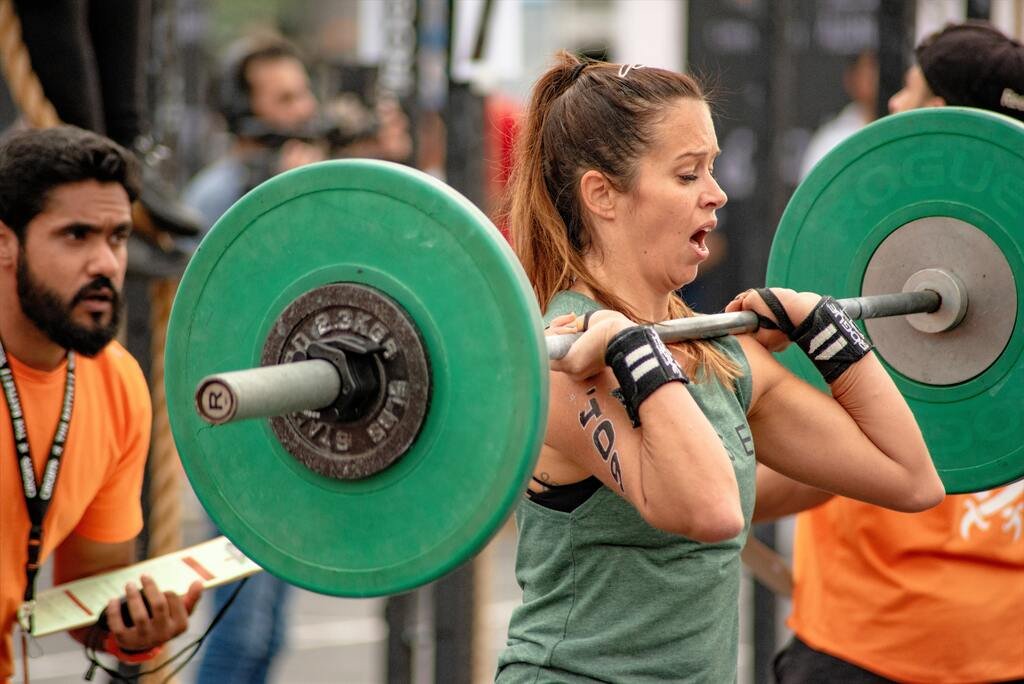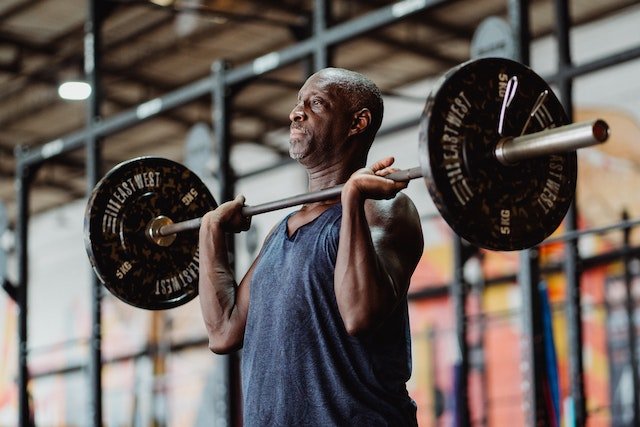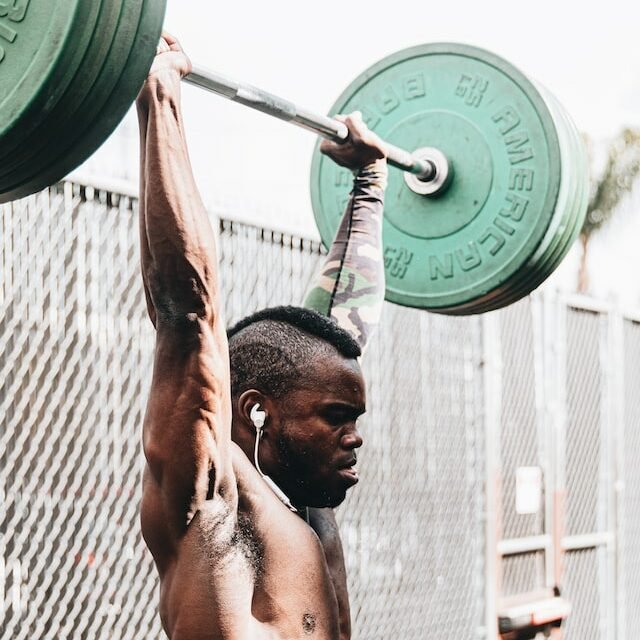
Why Do I Feel Shoulder Press in My Biceps? 14 Solutions For Rapid Progress
When most people do a shoulder press, they feel it predominantly in their anterior deltoids. But sometimes (or even often), people feel the shoulder press more in their biceps.
The sensation of feeling the shoulder press more in the biceps than deltoids can be quite confusing and naturally, you will want to know why it happens.
After all, the shoulder press should be targeting your deltoids more than anything else.
Fortunately, there are a few things that you can do to ensure you’re properly targeting the deltoids during your shoulder press.
So why does this happen? And is there anything that can be done about it? In this article, we’ll take a look at what might be causing this and some possible solutions.
Why Do I Feel Shoulder Press in My Biceps?
You may be feeling shoulder press more in the biceps than the deltoids if the exercise is new to you, as your body will take time to adjust to the new stimulus. However, the most common reason why someone might feel a shoulder press more in their biceps is because of improper form. Incorrect form can cause the bar to travel in an arced path which will cause the biceps to take on more of the load. Not engaging your core and glutes will compromise your stability and make your biceps work harder to stabilise the weight, while having too wide or narrow a stance can be another contributing factor to why the exercise is felt more in your biceps than shoulders. Incorrect form can be caused by elbows flaring out, too much wrist flexion, a grip that is too wide or too narrow, using too heavy of a weight, and/or a restricted range of motion. If these form issues are not corrected, the shoulder press will continue to be felt more in the biceps than the deltoids.
Let’s now look a little more in-depth at the reasons above and what you can do to fix them.
New exercise?
If you are new to shoulder pressing, it will take time for your body to adjust to the new stimulus, this is because the shoulder press works muscles which you may not have worked before.
This can cause fatigue and soreness in the biceps as it’s adjusting to the new movement and workload. So don’t be surprised if you feel shoulder press in your biceps at first, but also be aware that this should improve as your body gets more and more used to the exercise.
To get the best out of your shoulder presses and to target the deltoids as much as possible, start with a light weight and good technique. As you become stronger, you can start to increase the weight but be sure not to let your form slip.
One way to do shoulder press if the exercise is new to you would be to try the seated variation. This allows you to keep a better upright posture, which can prevent your body from cheating in order to lift the weight.
Give it a try and see how it compares to its standing counterpart.
Improper form
If you are experienced with shoulder pressing and still feel it more in your biceps, then this may be due to improper form.
There are a few things to bear in mind when doing this exercise to ensure that you are targeting your deltoids correctly.
To do shoulder press correctly, keep your elbows tucked in and your wrists straight. Make sure you have a wide enough grip on the bar, as too narrow of a grip can cause the bar to travel in an arced path which will cause the biceps to take on more of the load.
Also, make sure you don’t go too heavy. If the weight is too heavy, your form will suffer and this can cause the bar to travel in an arced path which will cause the biceps to take on more of the load.
Finally, make sure you are using a full range of motion; not locking your elbows at the top and going all the way down until your elbows are just below parallel.
If you keep these tips in mind, you should find that the shoulder press will start to feel more and more like a deltoid exercise.

Elbows flaring out
Another common cause of feeling the shoulder press more in your biceps is if your elbows are flaring out to your side.
The shoulders should be externally rotated and the elbows should be pulled in towards your sides.
To get this movement down, practice wall presses with a light weight. Start by standing close to the wall and pressing your arms up at various angles (inward, outward, and level) to see which angle feels the most natural for you.
Once you have found the correct angle, keep this in mind when doing the shoulder press and ensure that your elbows stay in the same position.
If you find that your elbows are flaring out, work on strengthening and stabilizing your shoulder muscles to ensure you are able to keep your elbows and wrists in the right position during the exercise.
Too much wrist flexion
If you find that you are flexing your wrists too much during shoulder press, then this could be causing the biceps to take on more of the load.
You want to make sure you keep your wrists straight in a neutral position and squeeze the bar. This will help to take the pressure off of your wrists and make sure the focus of the exercise is on the shoulders.
You also want to think about where the bar sits in your hand, too far back in your palm can cause you to flex your wrists too much. Make sure the bar is evenly distributed across your palm and keep those wrists straight.
By following these tips, you should find that the shoulder press will become more of a deltoid exercise and less of a biceps exercise.
To ensure you have a good grip on the bar, use an alternating grip instead of a double overhand grip. This will help to keep your wrists in a neutral position and make sure the focus of the exercise is on the shoulders.
With good technique and practice, you can make sure that the shoulder press is an effective exercise for building deltoid strength and not just a biceps exercise.
Related: Why do I feel overhead press in the middle of my back?
Grip width
Having the right grip width is also important to ensure that you are targeting the correct muscles. If your grip is too wide, then this can cause the bar to travel in an arced path which will cause the biceps to take on more of the load.
This may also result in flared elbows, so it’s important to keep your grip at the right width, so that the correct muscles are being activated.
Conversely, if your grip is too narrow, then this can also cause the bar to travel in an arced path which will cause the deltoids to take on more of the load.
To ensure you have the correct grip width, try using a wider than shoulder-width grip. This will make sure that the bar travels in a straight line and will ensure you are targeting the correct muscles.
Grip
Make sure you have the right grip on the bar. You want to make sure you are gripping the bar firmly but not too tight – a relaxed grip will help you maintain the right form and technique.
Just like having a grip that is either too narrow or too wide, you aren’t going to be getting the most out of the exercise if you aren’t using the correct grip.
This might take a little time to get used to, especially if you have been gripping the bar as if your life depended on it for some time, but once you get it right, you’ll be able to feel the difference and see those gains also.
Make sure to practice and get comfortable with the right grip before attempting heavy weights.
Too much weight
Another common reason people feel this exercise more in the biceps than the shoulders is due to using too heavy of a weight.
If you are putting on too much weight then this can cause your form and technique to suffer and can result in the bar travelling in an arced path which will cause not only the biceps to take on more of the load, but the rest of your body to try and stabilise the weight.
Try lifting lighter weights with good form and technique first and gradually increase the weight as you get stronger. This will help to ensure that you are targeting the right muscles and that you are lifting in the correct way.
Make sure you are using a suitable weight for your strength and fitness level. Just because you see others in the gym lifting heavy weights doesn’t mean that you should be too.
Bar path
It’s important to think about the path of the barbell when performing shoulder presses. You want to make sure that you are pressing the bar in a straight line, as this will ensure you are targeting the correct muscles.
If you find yourself pressing in an arced path then this can be an indicator that either your form is incorrect or you are using too heavy of a weight.
You can now download “Bar path” apps which draw out the trajectory of the bar as you lift it, so you can see exactly where the bar is travelling and make sure you are pressing in a straight line.
By making sure your form and technique are correct, you can ensure that you are targeting the right muscles and getting the most out of your shoulder presses.

Weak core and glutes
Your core and glutes play a huge role in stabilising your body when performing shoulder presses. If these muscles are weak, then this can cause your form to suffer and can lead to the bar travelling in an arced path which will cause the biceps to take on more of the load.
Make sure to include core and glute exercises in your workout routine, as this will help you stabilise your body and maintain the correct form.
When doing this exercise, you want to have the whole body alert and engaged to ensure that you are lifting in the correct way, because if you don’t, you won’t be getting the most out of your workout and you might pull a muscle if your core and glutes are too relaxed.
The same goes for the glutes, you need to have them braced and engaged to help you stabilise the load and ensure that you are targeting the correct muscles.
Restricted range of motion
If you are not extending your arms fully at the top of the movement, then this can mean that you aren’t targeting your deltoids correctly and you might be feeling the exercise more in your biceps than your deltoids.
Make sure to extend your arms fully at the top of the movement, as this will help to ensure that you are targeting the correct muscles and getting the most out of your workout.
You may have reduced range of motion (ROM) from a previous injury or due to tight muscles, so if you find that this is the case then make sure to stretch those areas out regularly and focus on building flexibility.
It can make a massive difference and be night and day in terms of how you feel the exercise in your body.
Related: Why can’t I do shoulder press?
Your Stance
Finally, your stance can also play a role in why you are feeling the exercise more in your biceps than your deltoids believe it or not.
If your stance is too wide then this can cause the bar to travel in an arced path which will again mean that the biceps take on more of the load.
This also applies if your feet are too close together, as this can cause instability and make it difficult to keep the bar travelling in a straight line.
Make sure you are standing in a comfortable position, with your feet slightly wider than shoulder-width apart, and that your weight is evenly distributed on both feet. This will ensure that you have the most stability and can keep the bar travelling in a straight line.
Some people also find that having a staggered stance works better for them, with one foot slightly in front of the other, but it really comes down to personal preference.
Final thoughts…
To summarise, the most common reason why someone might feel a shoulder press more in their biceps is because of improper form.
Incorrect form can be caused by elbows flaring out, too much wrist flexion, a grip that is too wide or too narrow, using too heavy of a weight, a restricted range of motion, weak core and glutes, and an incorrect stance.
If you make sure to correct these form issues and practice good technique and form then you should be able to target the correct muscles and feel your shoulder press more in the deltoids rather than in the biceps.
Good luck and remember to focus on form – it will make all the difference.
Have you encountered this and did you sort the problem? Let me know in the comments section below.


